これは短波放送の「見えるラジオ」といったところだ。今回もPERSEUSリモート受信で復調してみた。
テキスト文字は100%表示できる。FSKモードを16から128まで切り替え、同じ画像を送っていた。59.6カラットのダイアモンドの写真だ。
今年話題の彗星ISONの写真も送られてきた。カナリア諸島で撮影されたうっすらと尾を引く姿が見て取れる。30分番組のためテキストもかなり長い。MFSK128モードの表示スピードはとにかく速い。
このあとのハッブル宇宙望遠鏡とX線天文衛星チャンドラが小銀河M60-UCD1を観測したニュースは最近のVOAが伝えたもので、テキストではなく、HTMLソースのプログラムが送られてきた。
Before RSID: <<2013-09-28T16:01Z MFSK-16 @ 17860000+1500>>
Welcome to program 28 of VOA Radiogram from the Voice of America.
Here is the lineup for today's program (produced with Fldigi
3.21.76AG):
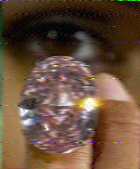
3:33 MFSK16: Program preview (now)
5:38 MFSK 16/32/64/128 images: Large diamond
3:45 MFSK32: BBC World Service archive
4:04 MFSK64: Deutsche Welle, Radio/TV Martí, with image
1:32 MFSK128: Willis Conover Facebook page, with image
:44 MFSK32: Email address
2:02 MFSK64: ISON comet, with image
2:29 MFSK64/Flmsg: Ultra-compact galaxy
:37 MFSK32: Closing announcements
Please send reception reports to radiogram@voanews.com
And visit voaradiogram.net
Twitter: @VOARadiogram
Next on VOA Radiogram will be the transmission of the same photo
in MFSK16, 32, 64, and 128.
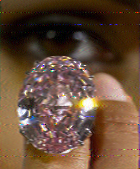
During each mode change will be 4 seconds of silence before and 6
seconds of silence after the RSID.
Each photo transmission is 1:20 to 1:30 in duration.
Photo caption: A 59.6-carat pink diamond that will be auctioned
by Sotheby's in Geneva at an asking price of $60 million...
Sending Pic:140x169C;
Before RSID: <<2013-09-28T16:07Z MFSK-32 @ 17860000+1500>>
Sending Pic:140x169C;
Before RSID: <<2013-09-28T16:08Z MFSK-64 @ 17860000+1500>>
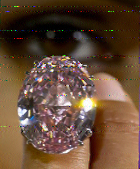
Sending Pic:140x169C;
Before RSID: <<2013-09-28T16:09Z MFSK-128 @ 17860000+1500>>
Sending Pic:140x169C;
Before RSID: <<2013-09-28T16:11Z MFSK-32 @ 17860000+1500>>
This is VOA Radiogram in MFSK32.
News about international broadcasting from kimandrewelliott.com.
A shortened URL for each post is below the headline.
Listeners are helping BBC validate World Service archive
metadata.

j.mp/1apoo24
BBC Internet Blog, 24 Sept 2013, Tristan Ferne: "The BBC World
Service Archive prototype allows you to search, browse and listen
to over 36,000 radio programmes from the BBC World Service
archive spanning the past 45 years. For a limited time you can
explore this archive and help us improve it by validating and
adding topic tags that describe the programmes. ... So far, users
of the prototype have listened to around 12,000 of the 36,000
programmes that are available and tagged or edited about 7,000 of
these. This has generated over 70,000 individual metadata 'edits'
(votes, new tags etc). We've even had some dedicated listeners
send us recordings of programmes that were missing from the
archive. We are currently analysing the data so far to see how
good the tags are by comparing professional archivists, listeners
and our algorithms."
The overlooked history of the international TV distribution
business.
j.mp/14IjsEA
Connect 2 Media & Entertainment, 25 Sept 2013, Dom Serafini:
One can find plenty of historical references about TV
technology, production, advertising and broadcasting. But for
academia, it's as if 50 years of international TV distribution
business never existed. And yet, international program sales made
commercial television viable and fostered its growth outside the
United States. If it weren't for American international
distribution, Canada couldn't have supported its first commercial
TV stations that later formed the CTV network. If countries such
as Mexico, Venezuela and Brazil hadn't started to export
Telenovelas in the 1950s and 1960s (first selling scripts, then
kinescoped versions and later, in 1965 versions on two-inch
videotapes), Latin America's TV industry couldn't have developed
as it did. If not for TV content sold internationally, Italy
couldn't have introduced commercial television in Europe. And
yet, very few records remain of those milestones."
VOA Radiogram now changes to MFSK64.
Next will be 4 seconds of silence, followed by the RSID for
MFSK64, followed by an additional 6 seconds of silence. If the
RSID does not change your mode to MFSK64, please do so
manually...
Before RSID: <<2013-09-28T16:15Z MFSK-64 @ 17860000+1500>>
This is VOA Radiogram in MFSK64.
News about international broadcasting from kimandrewelliott.com
Deutsche Welle's departing director on the roles on shortwave,
internet, television.
j.mp/1aoyekN
The Times of India, 19 Sept 2013, Deutsche Welle director general
Erik Bettermann as interviewed by Debasis Konar: "The importance
of shortwave has decreased dramatically almost everywhere,
largely due to increasing dominance of the internet. That's why
Deutsche Welle (DW) has reduced its shortwave radio programmes
significantly and invested more resources into its online
presence and television activities. ... Despite the increasing
importance of the Internet, radio is still a vital source of
information in many regions, where Internet access is limited. In
sub-Saharan Africa and parts of Asia, DW not only distributes its
radio content via shortwave, but also via partner stations. We
provide our users with audio files and podcasts in a variety of
languages. Many young people are accessing DW's audio offerings
through mobile devices even."
Director of Radio/TV Martí describes his station's media mix.
j.mp/16r0O7E
Radio Prague, 19 Sept 2013, Carlos Garcia-Perez, director of
Radio/TV Martí, as interviewed by Patrick McCumiskey: "We are a
multi media operation. ... Why is that? Well, there are two
primary reasons. Firstly, it's the most efficient way of carrying
on our operation today, and, as you know, the internet is a big
player. You (Radio Prague) play a big role on the internet now,
so internet and social media has changed the spectrum of how
information is disseminating and the availability of information.
Secondly, it is the attempt to jam us by the Cuban government.
And we go from the most primitive way of distributing
information, which is through flash drives and DVDs on the
island, where we put our radio and TV content to satellite. In
between those, we have an AM station, we have our own 1180
signal, but we buy time from commercial stations in Miami- that's
in a test period- but we do that because we know it reaches the
island, and we are getting great feedback from the island on
these. We are doing short wave and we are also testing FM. We
know the access to internet is a big component of distribution -
although we know access to the internet on the island is very
limited."
Photo follows: Radio/TV Martí director Carlos García-Pérez at
Radio Prague. Photo by Miloš Turek...
Sending Pic:200x152C;
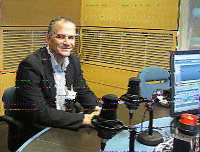
VOA Radiogram now changes to MFSK128.
Next will be 4 seconds of silence, followed by the RSID for
MFSK128, followed by an additional 6 seconds of silence. If the
RSID does not change your mode to MFSK128, please do so
manually...
Before RSID: <<2013-09-28T16:19Z MFSK-128 @ 17860000+1500>>
This is VOA Radiogram in MFSK128.
VOA's Willis Conover has a (memorial) Facebook page.
j.mp/14IjtZa
www.facebook.com/WillisConoverClub: "Willis Conover (1920-1996)
was one of VOA's treasures, an internationally-known jazz
aficionado, well-connected within the jazz community but
little-known in the United States." "Although few Americans knew
the name Willis Conover, his distinctive baritone was the voice
of jazz — that quintessentially American music — for millions
around the world. From 1955 until 1996, Conover's Music USA Jazz
Hour brought sounds that Louis Armstrong once called 'not too
slow, not too fast — kind of half-fast' to listeners of the U.S.
government-sponsored Voice of America radio service."
Photo of Willis Conover follows...
Sending Pic:205x256;
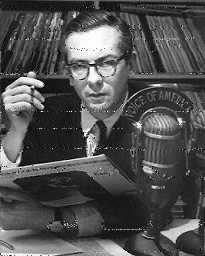
VOA Radiogram now changes to MFSK32....
Before RSID: <<2013-09-28T16:20Z MFSK-32 @ 17860000+1500>>
This is VOA Radiogram in MFSK32.
Please send reception reports to radiogram@voanews.com
And visit voaradiogram.net
Twitter: @VOARadiogram
VOA Radiogram now changes to MFSK64.
Next will be 4 seconds of silence, followed by the RSID for
MFSK64, followed by an additional 6 seconds of silence. If the
RSID does not change your mode to MFSK64, please do so
manually...
Before RSID: <<2013-09-28T16:21Z MFSK-64 @ 17860000+1500>>
This is VOA Radiogram in MFSK64.
ISON's Approach Captured by Amateur Astronomers
VOA News
September 24, 2013
Comet ISON was spotted and photographed by amateur astronomers as
the highly-anticipated arrival of the icy space visitor nears.
"I photographed Comet ISON on September 15 using my 4-inch
refractor," reports astrophotographer Pete Lawrence of Selsey in
the United Kingdom. "The comet's tail is nicely on view even
through this relatively small instrument."
In Aquadilla, Puerto Rico, astronomer Efrain Morales Rivera saw
the comet on September 14 "rising above the canopy of the rain
forest just minutes before sunrise. I used a 12-inch telescope,"
he said.
ISON, which will make its closest approach to the sun on November
28, has the potential to be a spectacular sight, depending on how
it reacts to the solar heating it will receive.
NASA, the U.S. space agency, said that in mid-September the
approaching comet was glowing like a star of 14th magnitude.
That's dimmer than some forecasters expected.
"Certainly we would love it to be a couple of magnitudes brighter
right now," said researcher Karl Battams of the Naval Research
Lab in Washington, D.C., "but it's doing just fine. I'd say it's
still on course to become a very eye-catching object."
NASA cautions that comets are capable of "fizzling at the last
minute even after months of promising activity."
However, if ISON survives its brush with solar fire, it could be
visible to the naked eye, NASA said.
Based on the latest images, internationally known comet expert
John Bortle said "ISON appears likely to survive the inbound leg
of its journey all the way to the Sun. It will probably brighten
more slowly than all the early hype led the public to believe.
Nevertheless, Comet ISON should very briefly become exceptionally
bright, at least rivaling the planet Venus in the hours preceding
its closest approach to the sun."
After November 28, ISON will emerge from the sun's glare
well-positioned for observers in the northern hemisphere. The
comet's tail will likely be visible to the naked-eye in both the
morning and evening sky throughout December 2013.
The last comet that did this sort of thing was Comet Lovejoy,
which gave viewers in the southern hemisphere a view of the
comet's tail stretching halfway across the sky.
http://www.voanews.com/content/isons-approach-documented-by-amateur-astronomers/1756181.html
Photo follows: Comet ISON as seen in September by astronomer
Nirmal Paul of the Canary Islands (NASA)...
Sending Pic:384x216;
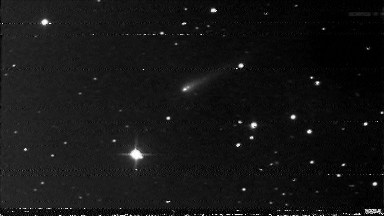
... start
:hdr_fm:19
VOA 20132609112223
:hdr_ed:19
VOA 20132609105105
:mg:2832
Voice of America
News / Science & Technology
Ultr a-Dense Dwarf Galaxy Discovered
VOA News
September 25, 2013
An "ultra-compact dwarf galaxy" has been spotted by astronomers.
The galaxy, known as M60-UCD1, has its entire mass in a radius of only 80 light years, compared to the Milky Way's
radius of 50,000 light years. That means the density of stars is about 15,000 times greater than the Milky Way, and
the stars are about 25 times closer.
"Traveling from one star to another would be a lot easier in M60-UCD1 than it is in our galaxy," said Jay Strader of
Michigan State University in Lansing, first author of a new paper describing these results. "But it would still take
hundreds of years using present technology."
Scientists hope M60-UCD1, which has the mass of 200 million suns, can provide clues on how galaxies evolved.
M60-UCD1 was seen by NASA's Hubble Space Telescope and follow up observations were made with NASA's Chandra X-ray Observatory and ground-based optical telescopes.
The galaxy is believed to have abundant amounts of heavy elements - elements heavier than hydrogen and helium -
which makes it a "fertile environment for planets and, potentially, life to form," said co-author Anil Seth of the
University of Utah.
Another intriguing aspect of M60-UCD1 is that the Chandra data reveal the presence of a bright X-ray source in its
center. One explanation for this source is a giant black hole weighing in at some 10 million times the mass of the
Sun.
"We think nearly all of the stars have been pulled away from the exterior of what once was a much bigger galaxy,"
said co-author Duncan Forbes of Swinburne University in Australia. "This leaves behind just the very dense nucleus
of the former galaxy, and an overly massive black hole."
If that happened, the galaxy would have been 50 to 200 times more massive than it is now.
Researchers believe the galaxy is more than 10 billion years old and that it has been "stalled" at this size for
several billion years, and it is about 60 million light years from Earth.
A paper on M60-UCD1 has been published in the September 20th issue of The Astrophysical Journal Letters.
www.voanews.com/content/
dwarf-dense-galaxy-discovered-m60ucd1/1757137.html
... end
Voice of America
News / Science & Technology
Ultra-Dense Dwarf Galaxy Discovered
VOA News
September 25, 2013
An "ultra-compact dwarf galaxy" has been spotted by astronomers.
The galaxy, known as M60-UCD1, has its entire mass in a radius of only 80
light years, compared to the Milky Way's radius of 50,000 light years. That
means the density of stars is about 15,000 times greater than the Milky
Way, and the stars are about 25 times closer.
"Traveling from one star to another would be a lot easier in M60-UCD1 than
it is in our galaxy," said Jay Strader of Michigan State University in Lansing,
first author of a new paper describing these results. "But it would still
take hundreds of years using present technology."
Scientists hope M60-UCD1, which has the mass of 200 million suns, can provide
clues on how galaxies evolved.
M60-UCD1 was seen by NASA's Hubble Space Telescope and follow up observations
were made with NASA's Chandra
X-ray Observatory and ground-based optical telescopes.
The galaxy is believed to have abundant amounts of heavy elements - elements
heavier than hydrogen and helium - which makes it a "fertile environment
for planets and, potentially, life to form," said co-author Anil Seth of
the University of Utah.
Another intriguing aspect of M60-UCD1 is that the Chandra data reveal the
presence of a bright X-ray source in its center. One explanation for this
source is a giant black hole weighing in at some 10 million times the mass
of the Sun.
"We think nearly all of the stars have been pulled away from the exterior
of what once was a much bigger galaxy," said co-author Duncan Forbes of
Swinburne University in Australia. "This leaves behind just the very dense
nucleus of the former galaxy, and an overly massive black hole."
If that happened, the galaxy would have been 50 to 200 times more massive
than it is now.
Researchers believe the galaxy is more than 10 billion years old and that
it has been "stalled" at this size for several billion years, and it is
about 60 million light years from Earth.
A paper on M60-UCD1 has been published in the September 20th issue of The
Astrophysical Journal Letters.
www.voanews.com/content/dwarf-dense-galaxy-discovered-m60ucd1/1757137.html
Before RSID: <<2013-09-28T16:27Z MFSK-32 @ 17860000+1500>>
Please send reception reports to radiogram@voanews.com
And visit voaradiogram.net
Twitter: @VOARadiogram
Thanks to colleagues at the Edward R. Murrow shortwave
transmitting station in North Carolina.
I'm Kim Elliott. Please join us for the next VOA Radiogram.
This is VOA, the Voice of America.
